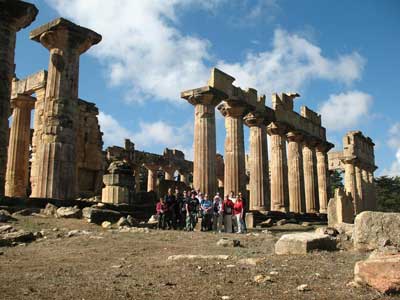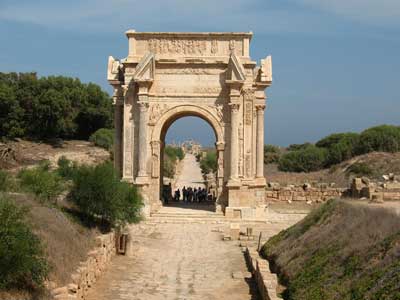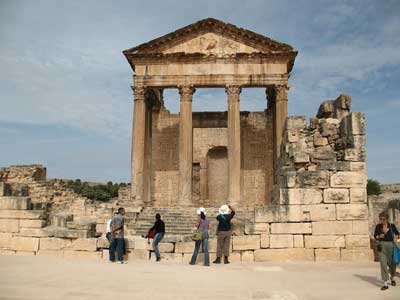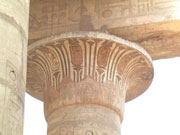TOUR NEWS - ANCIENT NORTH AFRICA OCTOBER 2008
The October 2008 Tour of Roman North Africa (Libya and Tunisia) took place from the 11th October to the 1st November. The group included: Sherryl Bremner, Robin and Robert Callister, Jane and Mike Costello, Catherine Doherty and Nola Thompson, Karen Hoare, Naida and Philip Lawrence, Lorraine Shackell, Brendan and Colin Shepherd (who were both on the March Egypt Tour as well), and Tracey Shand (who continued her travels from the tour of Italy).
Our Singapore Airlines flight took us via Egypt - we arrived in Cairo in the early morning and were in transit for our onward flight to Benghazi. A memorable event was the fact that we personally collected our luggage from the tarmac and took it with us on our bus to the plane (very Egyptian!). Our connecting flight took us to Benghazi in eastern Libya where we are met by our Libyan representative Sanussi. A drive through the picturesque Gebel Akhdar (Green Mountains) brought us to the small town of Bayda.
The next day we explored the stunningly beautiful classical site of Cyrene which has glorious views along the coast. We walked around the Roman Forum and Basilica, and saw the attractive mosaics in the House of Jason Magnus. The old Greek Agora contains remarkable buildings and sculpture from the early days of the site. We had lunch in a cafe and then saw the romantic temple of Apollo, the superb theatre and the Hadrianic baths. At the end of the day we saw some of the impressive Hellenistic tombs. The following morning we visited the museum of Cyrene which contains an astonishing array of sculpture from the Archaic Greek Period down to the late Roman Period. We then saw the magnificent temple of Zeus, rebuilt in the Second Century AD to replace an earlier Doric Temple - Brendan faithfully recreated the statue of Zeus for us. In the afternoon we explored the ruins of Apollonia, ancient port of Cyrene. These include a theatre, baths and early Christian churches.
 |
 |
The group at the Temple of Zeus at Cyrene |
The Arch of Septimius Severus, Leptis Magna |
On the 15th October we returned to Benghazi through the rugged Green Mountains. On the way, we stopped to see the ruins of the Graeco-Roman city of Ptolemais including the well preserved theatre, houses with mosaics and the Roman cisterns. It was a clear hot day and we had a picnic lunch before visiting the local museum of antiquities. In the late afternoon we flew from Benghazi to Tripoli, modern capital of Libya, and checked into our seaside hotel (the Bab el Bahr - which means 'Gate of the Sea').
The following two days were spent exploring the extensive ruins of Leptis Magna, undoubtedly one of the most spectacular Roman sites anywhere in the world. The city was founded by Phoenician traders and became a significant urban centre in the Roman Period when a new Forum was added. We explored the main part of the city including the impressive Arch of Septimius Severus, the theatre, the Hadrianic baths, the Severan Forum, the Basilica as well as the lighthouse and amphitheatre. The site was blissfully free of 'tourists'. We also visited the superb site museum which contains an outstanding collection of Roman sculpture. On the second day we also saw the remarkable Villa Sileen, an elite Roman residence justly famous for its superb mosaics and frescos.
We spent the morning of the 18th Oct at the national museum in Tripoli, home to a breathtaking collection of Roman period sculpture and mosaics. The museum is located in the old fort which guarded the medieval port of Tripoli. We also visited the arch of Marcus Aurelius, one of the few standing remains from Roman Tripoli, and saw a mosque. In the afternoon we had time for a rest and some members of the group went for a walk in the markets of the Old City to do some shopping.
Our last day in Libya was spent visiting the Roman site of Sabratha, located on the seashore a short bus ride west of Tripoli. This ancient port city is well preserved. Monuments of special interest included the superb Roman theatre dating to the late Second Century AD, and the dramatically located Temple of Isis overlooking the Mediterranean Sea. The Forum, located on the sea shore, contains a number of well preserved temples, a bath complex and the Senate House. In the afternoon we returned to Tripoli where we have time to relax and pack our bags.
 |
 |
The theatre at Sabratha |
The triumph of Neptune, mosaic in the Bardo Museum |
On the 20th October we flew to Tunis, modern capital of Tunisia - the processing of our visas took a while so we got to know the airport fairly well. We met our Tunisian guide Najari and finally checked into our hotel (the Hana International) - we then went for a leisurely walk along the boulevards of the new city of Tunis (the so-called Ville Nouvelle). This part of Tunis was built by the French in the late 19th Century and is full of excellent cafes where one can stop to watch life pass at leisure.
While in Tunis we visited the Bardo Museum, which contains a magnificent collection of Roman mosaics. These masterpieces are derived from a number of Tunisian sites and show many aspects of ancient life and religion. The collection is housed in a beautiful Ottoman Palace together with sculpture and art objects that are representative of Tunisian history. We also went for a walk in the Medina (the old city of Tunis) with its busy shopping district and the Great Mosque, a wonderful mediaeval building reflecting the rich Islamic traditions of Tunis. We also enjoyed a coffee in the old suq (covered markets) and watched the chechiya (felt hat) makers at work.
We then spent a morning exploring the ruins of the ancient Punic and Roman city of Carthage, a site which is located a short drive north of Tunis. We explored the old Punic port area and the Tophet Cemetery of the sacrificed children, the Roman amphitheatre, and the Bursa Hill acropolis and Carthage Museum. In the afternoon we spent some time in the district of Sidi Bou Said with its spectacular views of the Bay of Tunis. This area is well known for its blue painted doors, shops and coffee houses.
On the 24th October we went by bus through scenic farmland to the ancient Punic town of Kerkouane which is located next to the sea on Cape Bon, a peninsula east of Tunis. This is the best preserved Punic city in the world and is justly famous for the preservation of its houses with some of the earliest mosaic floors in the Mediterranean. We toured the local archaeological museum at Kerkouane and spent the afternoon in the fortress of Kelibia. On the way back to Tunis we diverted to see the remarkable Carthage aqueduct which runs for more than 90 km and must be one of the great engineering marvels of the ancient world!
The following morning we left Tunis by bus and passed through the green Medjerja River Valley. In the late morning we arrived at the magnificent ancient Roman site of Dougga - here we explored the near intact ruins of the town. Highlights included the Capitol (Temple of Jupiter), the Roman theatre, the bath complex and numerous houses with mosaic floors. In the afternoon we checked into our hotel in El Kef, a picturesque hill town with panoramic views of the local countryside. The following day we visited the Sufi school with its ethnographic collection of Berber artefacts and explored the Ottoman fortress. We then had a memorable lunch which included a bowl of delicious molokiya soup with chunks of lamb (the resemblance to a swamp was purely accidental!). In the afternoon we made our way south to Sbeitla, location of the ancient Roman city of Sufetula.
The fascinating ruins of the ancient city of Sufetula are spread over a wide area. One of the best preserved buildings is the awe inspiring Temple of Minerva in the Roman forum, still retaining its original architrave and roof blocks. Other highlights included the Roman baths, the Arch of Diocletian, and a Roman bridge. Our lunch was made more dramatic by the fact that a group of French tourists parked their vintage cars around our bus requiring us to push quite a few of them out of the way in order to get out!
 |
 |
Exploring Dougga |
The remarkable amphitheatre at El Jem |
On the 28th October we headed east to the coastal city of Sousse. We stopped en route in the mediaeval city of Kairouan, an ancient walled city which was founded shortly after the Arab invasion in the 7th Century AD. The most impressive building is the Aghlabid Grand Mosque which incorporates numerous columns from dismantled classical buildings. Colin bought a carpet and then realised he faced the challenge of getting it home. In the afternoon we headed to Sousse on the coast.
Our final excursion was to El Jem, location of the ancient Roman city of Thysdrus. In the morning we saw the Museum of El Jem which houses one of the world's best collections of Roman mosaics. A highlight was the reconstructed 'House of Africa' which enables the visitor to walk through an ancient Roman Villa. In the afternoon we explored the awe inspiring El Jem amphitheatre - this still retains its underground cells for animals and gladiators. On the last day of the tour we travelled by bus to Tunis where we had a final chance to do some shopping. A pleasant farewell lunch was had at a restored merchant's house (Dar el-Jeld) - we all decided that we would like a similar house in Australia, staff included!
The North Africa tour for 2008 was a great success - this was demonstrated by the unflagging enthusiasm and interest of the group and by the fact that everyone did so well in their exam at the end of the tour!
Michael Birrell

